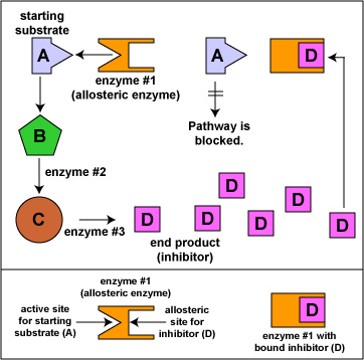What is feedback inhibition?
1 Answer
This is a form of enzyme inhibition in which the end product acts an an inhibitor. NB: the answer is a bit long but not hard to understand.
Explanation:
Some end products can control their own production. Consider the following diagram.

This is a representation of a biochemical reaction. These types of reactions generally occur in several steps or stages. Enzyme 1 will react with substrate A to produce substrate B. Substrate B reacts with enzyme 2 to produce substrate C which in turn reacts with enzyme 3 to form the end product D.
When the concentration of D gets too high in comparison to substrate A (in this instance), it starts to inhibit the action of enzyme 1.
Notice that D will bond with the allosteric site on enzyme 1. Hence, end product inhibition or negative feedback inhibition is non-competitive. D will slow down enzyme activity as it bonds to the allosteric site of enzyme 1 and deforms the active site, and prevents the substrate from bonding to it, thus making the enzyme inactive.
HIgher concentrations of D mean that more inhibitors will be able to interact with more of enzyme 1, so more inactive enzymes will be produced. Again, less reactions will occur between substrate A and enzyme 1, so less of substrate B can be produced. If less of substrate B is produced, then less of substrate C is produced and subsequently, less D is produced in the end.
D will continue to act as an inhibitor until the concentration reverts to its normal levels (this would be as a result of the body using it up). Once concentrations are lower, A will be able to interact with more of enzyme 1, so normal production of D can begin again.
Practical application
Respiration occurs in three steps, one of which is glycolysis. Basically, the energy we release is used to make ATP. ATP is what we use to do work. It is produced as needed. When we're exercising, we don't need as much ATP as when we're lying down. Therefore, there must be some function which controls the formation of ATP.
When too much ATP is produced, it begins to inhibit phosphofructokinase, an enzyme that reacts with fructose-6-phosphate to produce fructose-1-6-diphosphate (Don't be intimidated by the names. It's just the concept that's essential).
When the enzyme is inhibited, less fructose-1-6-diphosphate is produced so eventually less ATP will be produced, thus lowering ATP's concentration.

